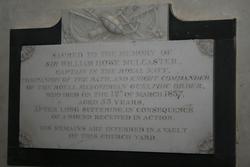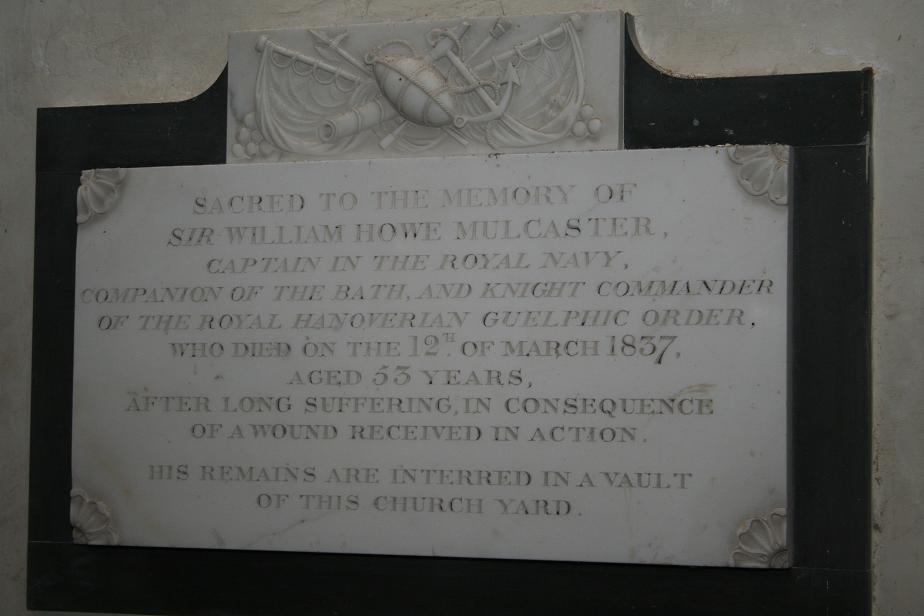He was an officer in the British Royal Navy who played a distinguished part in the Anglo-American War of 1812, in particular in the Engagements on Lake Ontario.
Son of Major General Frederick George Mulcaster (1739 - 1797) of the Royal Engineers and Mary Juliana Auchmuty (1750 - 1830), his father's second wife. His mother was a daughter of the Rev. Samuel Auchmuty DD (1725-1777), the Rector of Trinity Church, New York. It seems likely that he was named after General Sir William Howe, whom his father came to know as his ADC, when serving in America; they returned to England together in 1778.
He was baptised in St Helier, Jersey, Channel Islands on 30 October 1783, and was commissioned as a lieutenant in the Royal Navy in January 1800.
In 1809, he was serving as a Lieutenant in HMS "Confiance". One of his fellow officers was his future commander, James Lucas Yeo. "Confiance" played a significant part in the capture of Cayenne, for which Mulcaster received a commemorative sword from the Prince Regent of Portugal and was promoted to Commander. He was appointed to command the brig-rigged sloop of war Emulous serving at Halifax, Nova Scotia.
Shortly after war with America broke out in 1812, Emulous was wrecked on Cape Sable Island, and Mulcaster was recruited for service on the Great Lakes by Yeo (whose frigate, HMS Southampton had also been wrecked shortly before in the Caribbean). Mulcaster was initially offered command of the flotilla on Lake Erie but he declined on grounds of the scarcity of resources there. Instead, he acted as second in command to Yeo. In that role, he commanded the sloop Royal George in 1813 in several actions on Lake Ontario against the American squadron led by Isaac Chauncey. Both combatants on Lake Ontario were building progressively larger ships of war. Yeo laid down a frigate, to be named Prince Regent, and requested the Admiralty to promote Mulcaster to the rank of Post-Captain to command her. This was agreed.
Before the ship was launched, in late 1813, Mulcaster commanded several vessels from the Lake Ontario flotilla which were escorting supply convoys up the Saint Lawrence River.
He was an officer in the British Royal Navy who played a distinguished part in the Anglo-American War of 1812, in particular in the Engagements on Lake Ontario.
Son of Major General Frederick George Mulcaster (1739 - 1797) of the Royal Engineers and Mary Juliana Auchmuty (1750 - 1830), his father's second wife. His mother was a daughter of the Rev. Samuel Auchmuty DD (1725-1777), the Rector of Trinity Church, New York. It seems likely that he was named after General Sir William Howe, whom his father came to know as his ADC, when serving in America; they returned to England together in 1778.
He was baptised in St Helier, Jersey, Channel Islands on 30 October 1783, and was commissioned as a lieutenant in the Royal Navy in January 1800.
In 1809, he was serving as a Lieutenant in HMS "Confiance". One of his fellow officers was his future commander, James Lucas Yeo. "Confiance" played a significant part in the capture of Cayenne, for which Mulcaster received a commemorative sword from the Prince Regent of Portugal and was promoted to Commander. He was appointed to command the brig-rigged sloop of war Emulous serving at Halifax, Nova Scotia.
Shortly after war with America broke out in 1812, Emulous was wrecked on Cape Sable Island, and Mulcaster was recruited for service on the Great Lakes by Yeo (whose frigate, HMS Southampton had also been wrecked shortly before in the Caribbean). Mulcaster was initially offered command of the flotilla on Lake Erie but he declined on grounds of the scarcity of resources there. Instead, he acted as second in command to Yeo. In that role, he commanded the sloop Royal George in 1813 in several actions on Lake Ontario against the American squadron led by Isaac Chauncey. Both combatants on Lake Ontario were building progressively larger ships of war. Yeo laid down a frigate, to be named Prince Regent, and requested the Admiralty to promote Mulcaster to the rank of Post-Captain to command her. This was agreed.
Before the ship was launched, in late 1813, Mulcaster commanded several vessels from the Lake Ontario flotilla which were escorting supply convoys up the Saint Lawrence River.
Family Members
Advertisement
Advertisement







